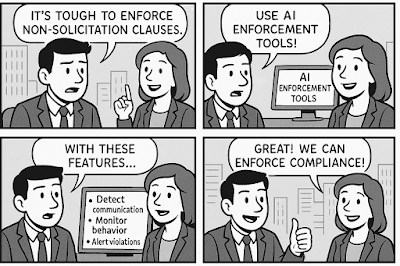Tools for Enforcing Non-Solicitation Clauses with AI
Non-solicitation clauses are vital in protecting your business from talent poaching and client diversion.
But enforcing them has traditionally relied on reactive legal action, manual monitoring, and burdensome discovery processes.
Now, AI-powered tools offer a proactive, real-time solution for detecting potential breaches and strengthening compliance in a legally defensible way.
📌 Table of Contents
- ⚖️ Why Non-Solicitation Matters
- 🧱 Limitations of Manual Enforcement
- 🤖 AI Tools Making a Difference
- 🧠 Real-World Use Cases
- 📜 Legal Considerations in 2025
⚖️ Why Non-Solicitation Clauses Are Business-Critical
Non-solicitation clauses protect your company by preventing former employees or contractors from luring away clients or colleagues after departure.
They're common in B2B service industries, consulting firms, sales teams, and SaaS companies handling sensitive accounts.
Enforcement ensures business continuity, team cohesion, and client retention in competitive environments.
🧱 Traditional Enforcement Limitations
Manual enforcement involves HR interviews, client complaints, and emails that surface too late.
This reactive approach is inefficient and weakens your legal standing due to lack of real-time evidence.
Additionally, small businesses often lack the resources to investigate effectively across platforms like LinkedIn, email, Slack, or CRM logs.
🤖 AI Tools That Monitor and Enforce in Real-Time
Modern AI tools help by continuously monitoring employee behavior and communication patterns.
Key features include:
• Natural language processing (NLP) to detect solicitation attempts in emails and messages
• Integration with Slack, Teams, and email systems for real-time scanning
• Alert systems for flagged content involving client names, recruitment language, or account movements
• Behavior-based analytics (e.g., mass contact exports or CRM anomalies)
🧠 Where AI Enforcement Makes the Biggest Impact
• Detecting if a departing salesperson emailed prospects post-termination
• Alerting HR if a consultant messages former clients from a new address
• Flagging Slack messages that reference client migration or hiring pitches
• Tracking high-risk user logins and unusual CRM downloads
📜 Legal & Compliance Considerations in 2025
In most jurisdictions, AI-based monitoring is legal when consent is given and scope is clearly defined in policies or contracts.
Always pair AI tools with clear user notifications, defined boundaries, and regular audits.
Logs generated by AI tools must be secure, time-stamped, and exportable for court use.
🔗 Practical Resources for Legal Monitoring & AI
Keywords: Non-Solicitation Enforcement, AI Legal Tools, Employee Monitoring, NLP Compliance, Client Poaching Prevention

